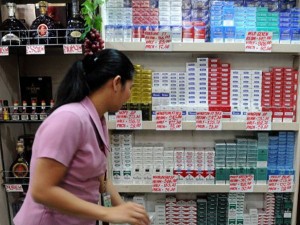
Due to the double-digit spike in the prices of so-called sin products such as cigarettes, the rate of rise in consumer prices came to a five-month high of 3.4 percent year on year in February, according to the National Statistics Office. AFP/JAY DIRECTO
The rate of rise in consumer prices came to a five-month high of 3.4 percent year on year in February due to the double-digit spike in the prices of so-called sin products.
The National Statistics Office also attributed growth in inflation to faster price hikes in the heavily weighted food and non-alcoholic beverage group.
The NSO on Tuesday reported that inflation revved up from 3 percent in January and 2.7 percent in February 2012.
The latest inflation figure is the highest since the 3.6 percent posted last September. This puts average inflation for the first two months of the year at 3.2 percent.
With higher excise tax rates taking effect in February, the index for alcoholic beverages and tobacco surged by 29 percent year on year—much faster than the 17.3 percent observed in January.
The uptick on food and non-alcoholic beverage also came out faster at 2.9 percent from 2.3 percent the previous month.
But on a sequential basis, prices rose by 0.3 percent compared with the levels seen the previous months. It was slower than the 0.5-percent increment seen in January.
The recent inflation data reflected the DBS Group’s forecast. Earlier this week, DBS said that the index would creep up further as more signs of rising consumer prices emerged.
The financial service provider said in a research note that inflation could no longer be contained as in the past year because of faster economic growth.
The same observation goes with the appreciation of the peso, DBS said, which had helped in reducing inflation for imported goods.
“However, a closer look into the breakdown of the CPI basket does show some early signs of demand-pull price pressure,” the bank said.
“More signs of inflation are likely to appear amid robust economic growth, especially once construction [of] public-private partnership (PPP) projects kicks in,” DBS added. “Oil prices will be another factor to watch.”